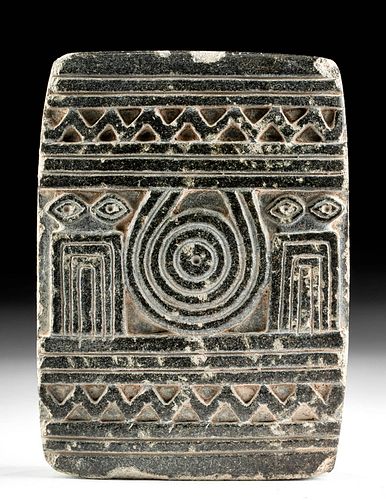Rare & Fine Sumerian Steatite Temple Stele w/ Eye Idols
Lot 114
About Seller
Artemis Gallery
686 S Taylor Ave, Ste 106
Louisville, CO 80027
United States
Selling antiquities, ancient and ethnographic art online since 1993, Artemis Gallery specializes in Classical Antiquities (Egyptian, Greek, Roman, Near Eastern), Asian, Pre-Columbian, African / Tribal / Oceanographic art. Our extensive inventory includes pottery, stone, metal, wood, glass and textil...Read more
Estimate:
$18,000 - $25,000
Absentee vs Live bid
Two ways to bid:
- Leave a max absentee bid and the platform will bid on your behalf up to your maximum bid during the live auction.
- Bid live during the auction and your bids will be submitted real-time to the auctioneer.
Bid Increments
| Price | Bid Increment |
|---|---|
| $0 | $25 |
| $300 | $50 |
| $1,000 | $100 |
| $2,000 | $250 |
| $5,000 | $500 |
| $10,000 | $1,000 |
| $20,000 | $2,500 |
| $50,000 | $5,000 |
| $100,000 | $10,000 |
| $200,000 | $20,000 |
About Auction
By Artemis Gallery
Oct 7, 2021
Set Reminder
2021-10-07 10:00:00
2021-10-07 10:00:00
America/New_York
Bidsquare
Bidsquare : Exceptional Antiquities Ethnographic Fine Art
https://www.bidsquare.com/auctions/artemis-gallery/exceptional-antiquities-ethnographic-fine-art-7537
Museum-worthy examples of Egyptian, Greek, Roman, Etruscan, Near Eastern, Far East / Asian, Pre-Columbian, African / Tribal, Oceanic, Native American, Spanish Colonial, Fossils, Ancient Jewelry, Fine / Visual Arts, so much more! Artemis Gallery info@artemisgallery.com
Museum-worthy examples of Egyptian, Greek, Roman, Etruscan, Near Eastern, Far East / Asian, Pre-Columbian, African / Tribal, Oceanic, Native American, Spanish Colonial, Fossils, Ancient Jewelry, Fine / Visual Arts, so much more! Artemis Gallery info@artemisgallery.com
- Lot Description
Ancient Near East, Mesopotamia, Sumer, Late Uruk Period, ca. 3500 to 3000 BCE. An incredibly rare example of a schematic stele bearing intriguing iconography and incised decorations, hand-carved from mottled steatite of a dark green, nearly black hue with beige and light grey inclusions. The rectangular stele features flat top and bottom faces, smooth lateral walls, and identical illustrations on the front and back face. Depicted on each face is a central bullseye-motif of concentric circles with two open rings on the exterior that open upwards towards a zigzagging serpentine form enclosed within two trios of concentric bars. Flanking the central circles are two temple facades, each surmounted by a pair of stylized, diamond-shaped eyes like those found on eye idols at the Anatolian archaeological site of Tell Brak. The bottom of each face bears an incised register identical to the top adornments that creates a wondrous presentation evocative of ancient Mesopotamia! Size: 3.4" W x 4.75" H (8.6 cm x 12.1 cm)
The Uruk period (ca. 4000 to 3000 BCE) was a period in the ancient world that existed from the proto-historic Chalcolithic to the Early Bronze Age and is correspondingly named after Uruk, one of the largest and most highly populated cities in ancient Sumer. The Uruk period saw the emergence of urban life, steady trading, artistic expression, and agricultural sustainability in Mesopotamia and is considered to be the formative phase of ancient Sumerian civilization. Votive stelae like this example are some of the earliest known examples of Mesopotamian art. They are predominantly filled with typical Sumerian motifs like abstract zoomorphic creatures, highly stylized anthropomorphic figures, and minimalist architectural elements. The importance of this example stems from the scarcity of this general item typology as it means that comparable examples are few and far between. However, the temple stele that contain abstracted images of 'eye idols' - like this example as well as the Michaux Stele in the Bibliotheque Nationale de France - are exceedingly rare.
Another example of a steatite temple stele, from a later period and with an integral eye idol projecting from the top, hammered for $40,000 at Christie's, New York "Antiquities" auction (sale 2450, June 9, 2011).
This item is accompanied by a copy of a CIRAM Scientific Report (no. 0517-OA-30N-3) - analysis performed by Dr. Olivier Bobin, New York, September 12, 2017.
This piece has been searched against the Art Loss Register database and has been cleared. The Art Loss Register maintains the world's largest database of stolen art, collectibles, and antiques.
Provenance: East Coast collection, New York Gallery, New York City, New York, USA, acquired before 2010
All items legal to buy/sell under U.S. Statute covering cultural patrimony Code 2600, CHAPTER 14, and are guaranteed to be as described or your money back.
A Certificate of Authenticity will accompany all winning bids.
PLEASE NOTE: Due to recent increases of shipments being seized by Australian & German customs (even for items with pre-UNESCO provenance), we will no longer ship most antiquities and ancient Chinese art to Australia & Germany. For categories of items that are acceptable to ship to Australia or Germany, please contact us directly or work with your local customs brokerage firm.
Display stands not described as included/custom in the item description are for photography purposes only and will not be included with the item upon shipping.
#153165Minor nicks and abrasions to top, base, peripheries, and some raised details on both faces, with light encrustations within some recessed areas, otherwise intact and near choice. Light earthen deposits and great traces of original iconography on both faces.Condition
- Shipping Info
-
All shipping is handled in-house for your convenience. Your invoice from Artemis Gallery will include shipping calculation instructions. If in doubt, please inquire BEFORE bidding for estimated shipping costs for individual items.
-
- Buyer's Premium



 EUR
EUR CAD
CAD AUD
AUD GBP
GBP MXN
MXN HKD
HKD CNY
CNY MYR
MYR SEK
SEK SGD
SGD CHF
CHF THB
THB















